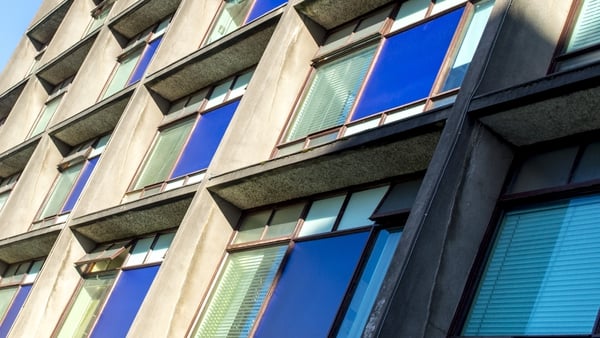On Tuesday 31 October, Irish architect Shane de Blacam received the 2023 Royal Academy of Arts Architecture Prize in London.
As co-founder of de Blacam & Meagher Architects and tutor to a golden generation of Irish architects, Shane de Blacam's name should be as well-known as his buildings.
But de Blacam never courted publicity and believed that architecture should speak for itself and that words distract from the task at hand.
"What architects say and write about their work is insignificant", he once declared.
Jury
The RA Architecture Prize jury tasked with selecting the fifth recipient of this award were architect Níall McLaughlin (Chair), architect Farshid Moussai, fashion designer Roksanda Ilinčić, artist Eva Rothschild RA, architect Sumayya Vally, and Head of Architecture and Drue Heinz Curator at the RA, Vicky Richardson.
The RA’s Architecture Prize, created in 2018, is special as it is chosen by practitioners from an independent body that does not receive government funding. The jury citation celebrates de Blacam’s dedication to community-centric spaces and the craft of his buildings.
Vicky Richardson stated, "We were impressed by Shane’s commitment to creating buildings that provide collective social spaces, spaces for gathering, for being seen and being together. They are grand spaces, but not of a grandeur that is overwhelming. It is very difficult to achieve in architecture as the grand gesture can take over the intimacy".
Early Years
Shane de Blacam was born in Dublin in 1945 to parents Mary (née McCarville) and Aodh de Blácam and has one sibling, Tarlach de Blácam (co-founder of the Inis Meáin Knitting Company). His father, who died when Shane was just six years old, was born Hugh Blackham in London with Irish heritage and Gaelicised his name after moving to Ireland in 1914.
He was a freelance journalist, one-time speech writer for Noël Browne, and a spokesperson for the Department of Health. Shane was educated in Blackrock College before going on to study architecture in UCD (1963 – 68). At nineteen, he spent the summer with an engineer uncle in Michigan, United States, where, at weekends, in a sleek 1949 Buick Roadmaster, he would seek out buildings by the great American architect Frank Lloyd Wright buildings in Michigan and neighbouring states.
A Love Of Brick
After graduating from UCD, he worked in London with Chamberlain, Powell and Bon Architects, an office best known for the design of the Barbican estate. In 1969, de Blacam won a Fulbright scholarship to pursue a Masters in architecture under philosopher-architect Louis Kahn (1901 – 1974) at the University of Pennylvania - Kahn would generally be considered part of the pantheon of modernist architects such as Le Corbusier and Mies van der Rohe. He recognised the talent of the Irishman and employed him post-graduation to work on the Kimbell Art Museum in Forth Wayne, Texas, and then to be his assistant in the detailed design of Yale’s Paul Mellon Center for British Art.
In a recorded lecture, de Blacam recalled of Kahn that "He was extraordinarily, kind and gentle and a great friend and deeply philosophical… his search was to find the meaning of building.’ Undoubtedly, he also bestowed on the young de Blacam a love of brick. In Philadelphia, de Blacam was also exposed to the influence of Scottish landscape architect and author of seminal book Design with Nature, Ian McHarg, who pushed for architects to understand and respect the natural world.
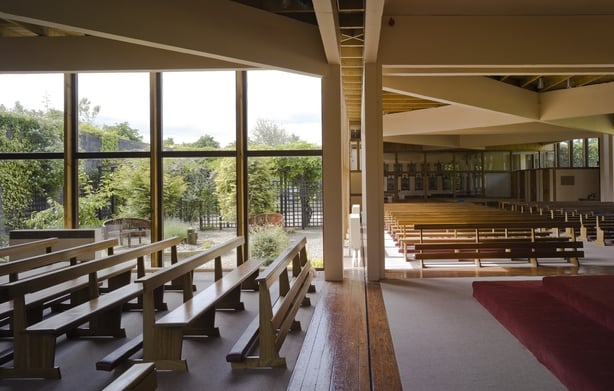
Teaching
Jury Chair Níall McLaughlin reflected on how de Blacam and Meagher represent a fascinating time in Irish architectural lineage, with "the continuity of practice through generations through either working in each other’s offices or teaching. Andy Devane did a fellowship with Frank Lloyd Wright, Cathal O’Neill worked with Mies van der Rohe, Robin Walker worked with Le Corbusier, Noel Dowley with Louis Kahn".
In 1972, de Blacam returned to Ireland to teach at the School of Architecture, UCD. Architect John Meagher (1947 – 2021) would also join the faculty. Meagher returned to Dublin after spending postgraduate years in Finland, and despite both working in Philadelphia at the same time (Meagher in the office of Venturi Scott Brown), the two men had never encountered each other.
De Blacam felt that his undergraduate education lacked architectural history and ensured that his students understood that they belonged to an ancient tradition whose sources, materials, and techniques they had to recognise and to whose quality they should aspire. Every Saturday, he would bring a group of students to houses like Francis Johnston’s neo-classical masterpiece Townley Hall or Beaulieu House and Gardens. These were buildings that created threshold spaces, that created a sense of arrival in their hallways and of transition in their staircases. He encouraged his students to build upon the endeavours of previous generations and to use the best materials the project could afford.
Next Generation
Níall McLaughlin also recalls how de Blacam constantly reinforced the importance of the drawing as part of the architect’s craft: "That a builder, once they picked up one of your working drawings, knows in their water, how much you know just by looking at your drawing. So, your authority lay in your ability to articulate ideas about buildings to people who built things every day… It belongs to the idea that you’re teaching somebody a core skill from which respect and ethics and everything else can grow out of that core skill".
De Blacam’s students included many members of Group ’91, an architectural collective who won the Temple Bar Framework Plan competition (1992) which included Shane O’Toole, Michael Kelly, Sheila O’Donnell and John Tuomey (O’Donnell + Tuomey Archiects), Siobhán Ní Éanaigh and Michael McGarry (McGarry Ní Éanaigh Architects), Shay Cleary, Derek Tynan, Paul Keogh, Rachael Chidlow, Niall McCullough and Valerie Mulvin (McCullough Mulvin Architects), also not his students but rather his colleagues Shelley McNamara and Yvonne Farrell (Grafton Architects). You can read more about de Blacam from the perspective of the student in Shane O’Toole’s recent piece for RA Magazine.
Communal Spaces
De Blacam and Meagher established their practice in 1976 to enter the Diocese of Dublin competition for Our Lady of Mount Carmel Church, Firhouse in 1976. Their first project (unbuilt) was the Taoiseach’s House and Guesthouse international architecture competition in 1979. They came joint second place. Another church of theirs was the Chapel of Reconciliation at Knock, which won an architectural competition held by the Archbishop of Tuam in 1989. The Chapel was the first Irish building to be shortlisted for the EU’s Mies van Der Rohe Prize for Contemporary Architecture. Their competition wins saw them collaborate with artists such as Seán Scully for the main entrance at the University of Limerick with the pair of 35-metre-high timber posts and thick black-and-white wall in stone (1996).
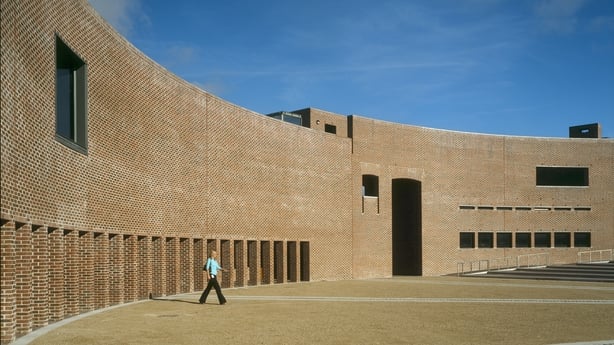
The Old Made New
De Blacam was not afraid to translate and transform older buildings because of his knowledge of natural materials, and was appointed Architectural Adviser in 1975 to the Royal Society of Antiquaries of Ireland and is also a Grade 1 Conservation Architect.
Reflecting on his first time collaborating with de Blacam & Meagher as client (later on the committee for the Trinity Dining Hall restoration) Prof Eddie McParland recalled: "In 1976 they prepared the rooms on the piano nobile for the infant Irish Architectural Archive (then known as the National Trust Archive). The smoking of the previous occupants of the two rooms – the Civil Service Bridge Club – had given a mahogany patina to the fine plaster ceilings. Disdaining current theories of ‘correct’ colouring of neo-classical plasterwork, they stripped back the paint (and tobacco) layers, and left the ceilings completely unpainted. The effect was brilliant, as if one was looking at a soffit in the Domus Aurea. It was very beautiful, and original. The old made new."
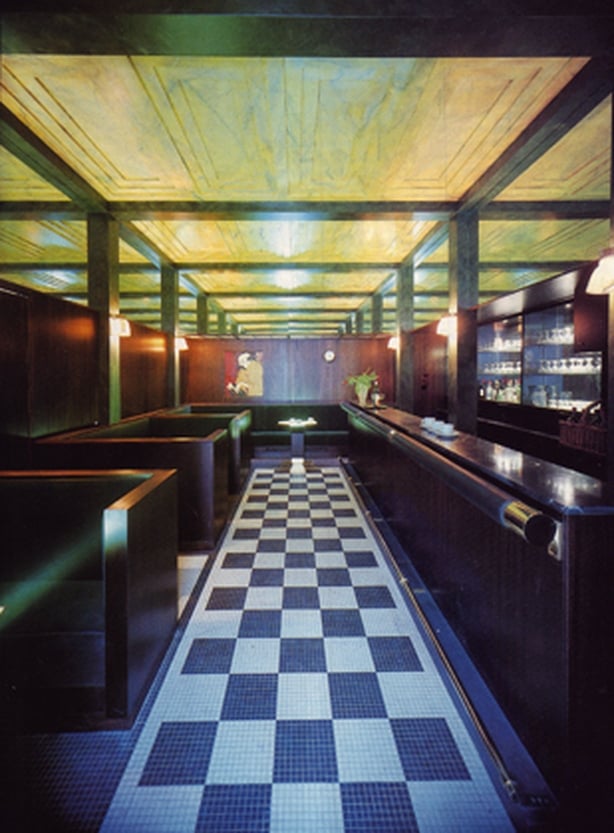
Trinity College
His interest in historical craftsmanship is apparent in the restoration of the Dining Hall of Trinity College Dublin after the 1984 fire, a project which won the practice a Europa Nostra Medal. Along with the dining hall came the insertion of an atrium and the creation of a new bar, a replica of Adolf Loos’ American Bar in Vienna. In Trinity, tribute should be paid to the chairman of the building committee; the late Professor Charles Holland. His triumph was in tolerating a very flexible brief, and he succeeded in giving the architects an unusual and well-deserved freedom in authorising their Atrium and Loos Bar.
You can hear de Blacam tell the story of the bar in this film made by the Irish Architecture Foundation as part of their Site Specific Series (2020) below.
We need your consent to load this Vimeo contentWe use Vimeo to manage extra content that can set cookies on your device and collect data about your activity. Please review their details and accept them to load the content.Manage Preferences
De Blacam would return to Trinity campus with the design of the Samuel Beckett Centre (1993), which won the Architectural Association of Ireland’s Downes Medal. De Blacam and Meagher’s other conservation projects include Maynooth Castle, which received the RIAI Special Award for Conservation and Restoration, 2002; RIAI Triennial Silver Medal for Conservation, a 19th century warehouse on Barrow Street (2001), restoration of the Lyons Demesne (2001) and restoration of Abbeyleix Library (2009).
Their residential buildings include the Castle Street mixed-use, Herbert Lane, Harold’s Cross houses and the Wooden Building in Temple Bar which in 2005 he received the RIAI Silver Medal for Housing.
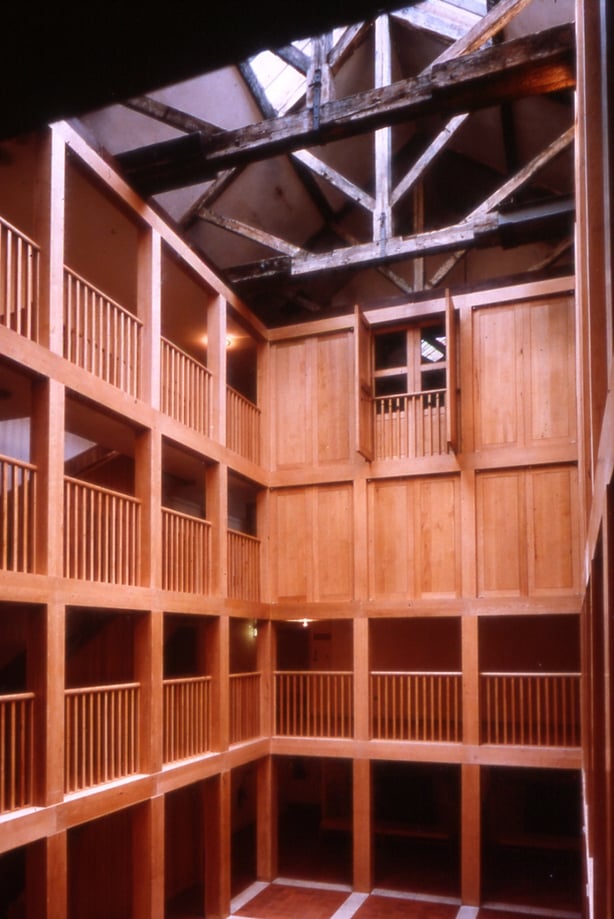
De Blacam was the master of that most fundamental of civic spaces, the library, and he has designed many including the Library for the School of Art in GMIT (1999), and the impressive CIT Library, where he also created an urban piazza for the school in an elegant curve, to show off the vast deployment of a single material, brick, running through to the interiors. De Blacam and Meagher have represented Ireland at the Venice Architecture Biennale several times, first in 1992. Tom de Paor and Peter Maybury then celebrated the work of the practice in Venice in 2010, with historian Roy Foster noting that they are "at once imaginative and respectful of their surroundings". Their work appeared most recently at the 2018 Biennale, and numerous accolades include the RIAI Gandon Medal for Lifetime Achievement 2021 and elected members of Aosdána by their peers.
New Audiences
The RA Architecture Prize offers an opportunity for new audiences to discover the work of de Blacam and Meagher. Vicky Richardson explained: "The giving of the award is not the end of it for us. We want to continue this discovery of his work to our audiences over the coming months. One thing we’ve done is to commission a young architectural photographer, Kaye Song, to make a new set of photographs to document Shane’s buildings in use which we will be releasing soon to broaden the knowledge of his work. This photo essay will be exhibited at the upcoming Guangzhou Triennial in China. I am curating a show of all the previous recipients of the award".
To complete the celebration of the craftsmanship of de Blacam, here are the words of architect and wordsmith Shane O’Toole: "Shane de Blacam is the greatest Irish architect of my lifetime. Perhaps I can say that because he was a powerful influence on my formation as an architect and because through my parents I had heard many tales of the architects of the previous generation, whose buildings I have since studied with immense care and respect. But there is more to it than that. In a celebrity obsessed era, when the world begs for flashbulb moments - even in architecture, where hollow-faced structures become the so-called iconic buildings of media fame - he continues to eschew all of that. Uniquely, there is an antique spirit to what he builds. His handmade buildings do not look old or old-fashioned. Nor are they shiny new. Instead there is an aura of the eternal about them, and therein rests the true power of architecture to move us. I have no doubt that in time to come they will constitute some of the finest and most meaningful ruins of our age. I can think of no greater compliment to offer an architect".
Thanks to the following for giving their time for interviews; Níall McLaughlin, RA Architecture prize jury chair, Shane O’Toole, architecture critic, Dr Edward McParland FRIAI (hon), Fellow emeritus TCD, and Vicky Richardson, Head of Architecture and Heinz Curator at Royal Academy of Arts.


